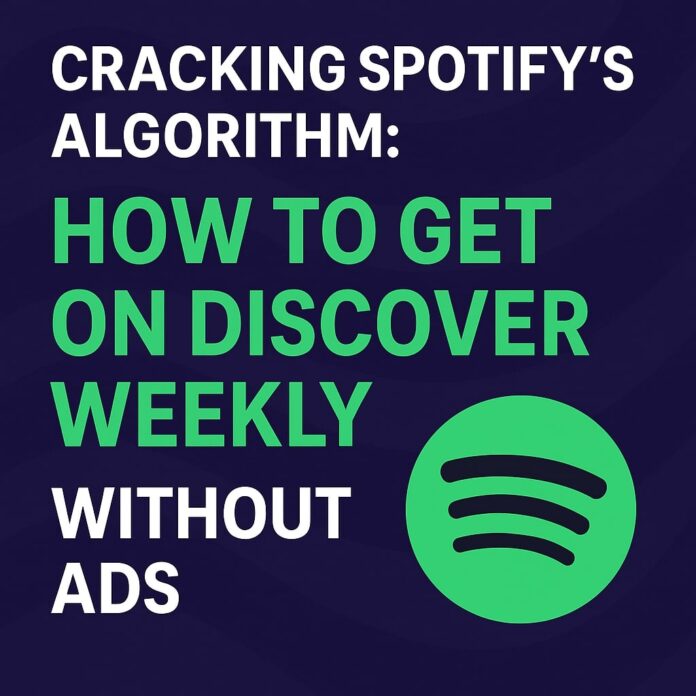
Cracking Spotify’s Algorithm: How to Get on Discover Weekly Without Ads
Want your music to appear on Spotify’s “Discover Weekly” playlist — without paying for ads? Good news: Spotify’s algorithm rewards strategy, not budget. With the right data signals, consistent engagement, and smart content distribution, you can organically trigger playlist placements that drive long-term stream growth and fan discovery.
In this guide, we’ll break down exactly how to work with Spotify’s algorithm (not against it) to boost your chances of getting featured on Discover Weekly and other algorithmic playlists.
Why “Discover Weekly” Matters
Spotify’s Discover Weekly is a personalized, algorithmic playlist updated every Monday for each user. It analyzes listening habits and serves 30 tracks similar to what the listener already enjoys — a massive exposure opportunity for emerging artists.
Getting on Discover Weekly can:
- Generate thousands of organic streams.
- Bring in highly targeted, repeat listeners.
- Improve your track’s data signals for future placements (like Release Radar and Radio).
Unlike editorial playlists, Discover Weekly is completely algorithm-driven, meaning any artist can get there — no label, ads, or pitch required.
Step 1: Optimize Your Track Metadata
Before your song even hits the algorithm, Spotify needs to understand what it is. Metadata tells Spotify where to categorize your track.
Make sure to:
- Use accurate genre tags and mood descriptors in your distributor’s submission.
- Include detailed credits (songwriters, producers, featured artists).
- Keep your track title and artist name consistent across all platforms.
Pro Tip: Avoid keyword stuffing in titles or descriptions — Spotify’s systems prefer clean, accurate tagging over manipulative tactics.
Step 2: Trigger the Right Engagement Signals
Spotify’s algorithm measures how listeners interact with your track. These “signals” determine whether your song fits into other users’ recommendations.
Key engagement metrics Spotify loves:
- Save rate: How often users save your track to their library or playlists.
- Completion rate: Percentage of listeners who play your song all the way through.
- Skip rate: The fewer skips in the first 30 seconds, the better.
- Repeat listens: A strong signal of listener satisfaction.
Encourage fans to:
- Save your track, not just stream it.
- Add it to their own playlists.
- Follow your artist profile (this boosts Release Radar reach too).
Step 3: Build Momentum in the First 7 Days
Spotify’s algorithm monitors early performance after release. This “first-week data burst” tells the system whether your track is worth recommending.
To maximize early traction:
- Promote pre-saves before release day.
- Drive traffic from social media, TikTok, and email lists within the first 48 hours.
- Encourage fans to listen all the way through — short attention spans can hurt your completion rate.
Bonus Tip: Upload at least 2–3 songs consistently every few months. The algorithm favors active, consistent artists over one-off uploads.
Step 4: External Traffic Still Counts
Spotify does notice off-platform activity. If people discover your song via YouTube, TikTok, or Instagram and then stream it on Spotify, that external momentum boosts your algorithmic credibility.
Strategies that work:
- Share 15–30 second clips on TikTok or Reels using your track’s Spotify link.
- Embed your track in blogs, press articles, or your own website.
- Collaborate with micro-influencers to share your song organically.
These external sources drive authentic listeners — exactly what Spotify’s algorithm values.
Step 5: Build Your Own Playlists
Spotify rewards active curators. When you build playlists around your genre or mood (and include your own tracks naturally), you can feed data to the algorithm and attract similar listeners.
Tips for effective playlisting:
- Mix your tracks with similar artists.
- Give playlists keyword-rich titles (e.g., Chill Indie Vibes 2025).
- Share them across your social channels.
- Keep playlists fresh — update them every few weeks.
Over time, Spotify begins associating your music with the listening patterns of those genres and artists — helping your tracks enter new users’ algorithmic feeds.
Step 6: Leverage Release Radar and Artist Follows
Spotify’s Release Radar automatically sends your new track to followers. Every time you release a song, you get a built-in boost from these loyal fans — which directly influences your Discover Weekly chances.
How to grow followers:
- Add a Spotify “Follow” button to your website and social bios.
- Use a smart link that includes a follow prompt.
- Engage regularly with fans via Spotify’s “Artist Pick” and canvas visuals.
Step 7: Analyze and Adjust
Use Spotify for Artists analytics to track which songs perform best in algorithmic playlists and where your streams are coming from.
Focus on:
- Listeners’ playlists: a sign your song resonates.
- Algorithmic streams: proof your strategy is working.
- Source of streams: to optimize future promotion.
Refine future releases based on what actually triggers growth — not what you assume works.
The Takeaway: Work With the Algorithm
Getting on Discover Weekly isn’t luck. It’s about consistent data, authentic engagement, and strategic growth.
To recap:
- Nail your metadata.
- Drive early engagement.
- Build long-term playlists and fan relationships.
- Keep releasing quality music.
When Spotify sees real people enjoying your music, the algorithm amplifies your reach — no ad spend required.
Final Word
If you’re an independent artist serious about sustainable growth, stop chasing ads and start feeding the system what it craves: authentic, high-retention listeners. That’s how you crack Spotify’s algorithm — and get on Discover Weekly organically.























 🔥 Limited Time: Get 55% OFF All Plans - Ends in:
🔥 Limited Time: Get 55% OFF All Plans - Ends in: